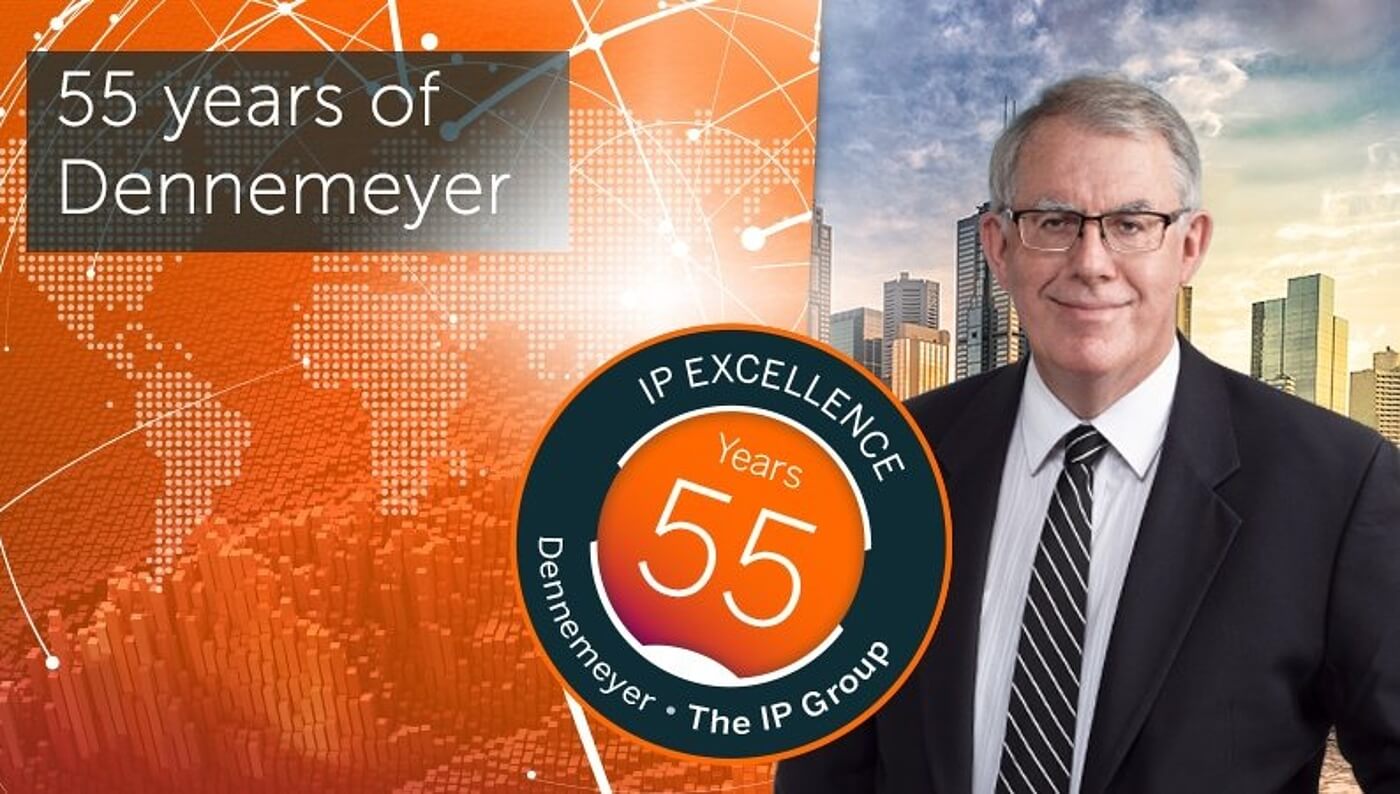
55 years of IP disruption – an homage from down under
My best wishes go to Dennemeyer! 55 years are a long time and I want to use the opportunity of this anniversary to send a couple of thoughts together with my birthday greetings – from another perspective and, of course, from down under.
What made Dennemeyer so unique and successful in the past decades that it was able to develop from a Luxembourg based patent law firm into the world’s most diversified IP full-service provider? From my perspective, Dennemeyer is a key driver – if not the center – of a fundamental transition of the global IP industry. A shift that has led to such massive changes that the buzzword “disruption” is adequate to describe it (even though I personally still prefer the term “transition”). Dennemeyer has been able to adapt to the changes concerning all stakeholders.
Who are these key stakeholders? In its simplest form, there are the IP owners themselves (individuals and corporations) seeking IP rights consistent with their business objectives; governments through their agencies providing the IP infrastructure to obtain IP rights – at the international, national and multilateral or regional levels, and the IP service providers. This latter grouping can be further categorized into:
- The traditional attorney services;
- The commoditized type services (such as renewals);
- The management services (such as outsourcing).
Looking at how all of these stakeholders have changed, shows a high level of disruption (or transition).
IP owners
IP owners are the cornerstone - or ultimate drivers - of the sector in that they seek, demand and require IP rights with certainty while pursuing maximum protection (both in terms of scope and territory). Such rights are being provided in the minimum time frame (usually), at minimum cost but, at the same time, without any reduction in quality of service or outcomes. While these objectives might be considered aspirational, they nonetheless provide the primary drivers for the rise of the Dennemeyer Group that has been able to adapt to their needs quicker and better than most other competitors.
IP service providers
Before considering the IP service providers, it is well worth reviewing the IP life cycle for the purpose of broadly categorizing the activities (services and/or products) performed (and by whom) in a typical IP life cycle. The patent life cycle is used here for illustrative purposes, but other registrable IP rights such as trademarks and industrial designs could equally act as an example. The patent life cycle commences with pre-filing considerations, the most common being the conduct of suitable patent searches. Following the search activity, the patent document will be prepared (drafting) and then filed (either as a priority or convention/international application). Next comes the prosecution or examination stage which is leading to grant or registration, finally concluding with maintenance (such as annuities or renewals). It should, however, be recognized that depending on the jurisdiction, such maintenance fees may be payable before or concurrently with the registration stage. Although not strictly a linear process, for this example, subsequent commercialization and/or enforcement can be regarded as the final stage(s) in this IP life cycle. Today, the Dennemeyer Group offers services for each of these life cycle stages of an IP right.
The origins: traditional IP attorney service providers
As already identified, there are virtually three major groups of players in the IP service providers sector – the traditional IP attorney services, the commodity product/service providers and IP management and related outsourcing service providers. It is difficult to put an exact date on changes, but it is reasonable to assert that all elements of the IP life cycle just described were once the sole domain of the traditional attorney service providers. One of the pioneering changes to this framework happened in 1962 when John Dennemeyer introduced the first computer based patent annuity payment service. It can indeed be argued that this was the invention of a new type of service provider – the commodity service provider.

Most elements of the IP life cycle were once the domain of the traditional attorney service provider. That changed completely with the advent of information technology and John Dennemeyer’s computer based patent annuity service.
Commodity service providers
Reverting to the IP life cycle, the logical commencement point is the searching component. Today, we see a multitude of searching options offered by the commodity services providers to the IP owners (and to the attorney service providers). These searching solutions include freely available databases such as PATENTSCOPE and Espacenet provided by government agencies – either international (WIPO) or national IP offices. Commercial databases are also available, and these all tend to give some functionality benefit over and above the government agency products. It is this differentiation of functionality that creates the marketplace for such commodity service providers. Such type of differentiation is based on interfacing, detailed analytics, language translation capability, statistical analysis, graphical and topographic presentation of results, citation analysis, and the like. Therefore, it is not surprising that searching has been a fertile field for entry of commodity service providers as part of their service is highly dependent upon information searching and analysis. To put this in perspective, the number of patents filed worldwide per year increased three fold from 1980 to 2010, and five fold in the case of trademarks. Hard disk drive capacity increased 100,000 fold in the same period.
Perhaps the two elements in the IP life cycle that have most rapidly become commonplace in the IP ecosystem are the maintenance and filing commodity services. The nature of each of these elements are readily transferable as a commodity, and in each case, the entry of providers such as Dennemeyer triggered some initial disruption, but such services have been subsequently improved and enhanced, mainly due to the aforementioned explosion of advances in information technology.
The other two pre-registration elements are patent drafting and patent examination/prosecution. In the case of drafting, underlying tasks such as identifying relevant prior art, interaction with the client, evaluating the scope of an invention, etc., cannot be readily replaced by computers. However, as already identified, some searching and analytical software can assist the patent attorney particularly in determining prior art, and already there are some purveyors of software tools that electronically enhance the drafting process. Although not necessarily at the “IT level,” government agencies (international and national) have become drivers for the examination/prosecution phase to become more of a commodity. Offices sharing examination reports, patent prosecution highways, the use of modified examinations, together with rapidly evolving information technology capabilities are pushing this aspect more towards a commodity. As an example, and building on these developments, Dennemeyer has introduced the concept of Flat Fee Prosecution whereby IP owners can benefit from many of these developments.
These tools include IP management software, discovery and litigation management, lawsuit databases, attorney-client management, knowledge management and document management. The development of such broader based software solutions across an IP owner’s business (particularly those with large portfolios) provides a convenient segway into the third group of IP management and related outsourcing service providers.

As I have indicated, such outsourced services can be as narrow or broad as the client requires, but ultimately the client (IP owner) needs to fully understand its workflows so that it can identify what service(s) can be best outsourced – that is, they are demand driven, not supply driven. Aligned with this consideration is the question by the IP owner “what competencies and processes do we (or should we) keep in house?”. Ultimately, there must be tangible benefits in outsourcing services, and these benefits broadly fit into three categories, such as improved services, cost effective services and more efficient services. Further, it should not be forgotten that outsourcing is a partnership between two or more parties. Finally, management, communication and relationship issues (both current and potential future) need to be openly and transparently identified and addressed at the outset of any outsourcing partnership.
Another 55 years of disruption?
All companies are different and use IP services in different ways to meet their business objectives. For example, does the IP owner utilize an internal corporate department or rely solely on an external supplier(s), or some hybrid? Further, where it outsources, does it outsource “products” and/or “services”?
A short conclusion of a long speech: Dennemeyer has been in the center of a massive transition. Obviously, it has been there at the right time with exactly the right services and tools. Or more accurately: with the right people and the right clients that supported its development into a global IP full-service provider. Congratulations! Should the next 55 years be as eventful, we can expect a lot more disruption!
55 years of Dennemeyer is a birthday not to be celebrated only by us and our clients. Every company that sources IP services is invited to benefit from our anniversary campaign by making use of our very special present: Ask for a preferential price for one or more of our 41 IP services which you are currently not yet sourcing from us. The only condition: the service(s) must be new for you.
Good that we have it all!
 The above article is part of series. Read the other blog posts of our article series “55 years of Dennemeyer“ here:
The above article is part of series. Read the other blog posts of our article series “55 years of Dennemeyer“ here:
- “30 years of Dennemeyer Japan”, by Futoshi Anouma
- “33 years of Trademark Renewals”, by Maryse Heirend
- “55 years of IP history – the right time to take off”, by Stefan Rautenberg
- “The digitalization of patent annuity payments”, by Romain Hoffmann
- “As time goes by – a lookback on the year 1962”, by Leon Steinberg
Filed in

Exploring an alternate 2025 where patents are made weaker by design to encourage sustainable innovation.



